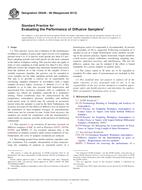Potrebujeme váš súhlas na využitie jednotlivých dát, aby sa vám okrem iného mohli ukazovať informácie týkajúce sa vašich záujmov. Súhlas udelíte kliknutím na tlačidlo „OK“.
ASTM D6246-08(2013)
Standard Practice for Evaluating the Performance of Diffusive Samplers
Automaticky preložený názov:
Štandardné praktiky pre hodnotenie výkonnosti difúznych vzorkovacích
NORMA vydaná dňa 1.4.2013
Informácie o norme:
Označenie normy: ASTM D6246-08(2013)
Poznámka: NEPLATNÁ
Dátum vydania normy: 1.4.2013
Kód tovaru: NS-34380
Počet strán: 8
Približná hmotnosť: 24 g (0.05 libier)
Krajina: Americká technická norma
Kategória: Technické normy ASTM
Anotácia textu normy ASTM D6246-08(2013) :
Keywords:
accuracy, air monitoring, bias, concentration, diffusive, evaluation, gases, passive, performance, precision, sampling and analysis, samplers, tests, uncertainty, vapors, workplace atmospheres, ICS Number Code 13.040.30 (Workplace atmospheres)
Doplňujúce informácie
| Significance and Use | ||||||||||||||
|
5.1 Gas or vapor sampling is often accomplished by actively pumping air through a collection medium such as activated charcoal. Problems associated with a pump–inconvenience, inaccuracy, and expense–are inextricable from this type of sampling. The alternative covered by this practice is to use diffusion for moving the compound of interest onto the collection medium. This approach to sampling is attractive because of the convenience of use and low total monitoring cost. 5.2 However, previous studies have found significant problems with the accuracy of some samplers. Therefore, although diffusive samplers may provide a plethora of data, inaccuracies and misuse of diffusive samplers may yet affect research studies. Furthermore, worker protections may be based on faulty assumptions. The aim of this practice is to counter the uncertainties in diffusive sampling through achieving a broadly accepted set of performance tests and acceptance criteria for proving the efficacy of any given diffusive sampler intended for use. |
||||||||||||||
| 1. Scope | ||||||||||||||
|
1.1 This practice covers the evaluation of the performance of diffusive samplers of gases and vapors for use over sampling periods from 4 to 12 h and for wind speeds less than 0.5 m/s. Such sampling periods and wind speeds are the most common in the indoor workplace setting. This practice does not apply to static or area sampling in wind speeds less than 0.1 m/s, when diffusion outside the sampler may dominate needed convection from the ambient air to the vicinity of the sampler. Given a suitable exposure chamber, the practice can be extended to cover sampler use for other sampling periods and conditions. The aim is to provide a concise set of experiments for classifying samplers primarily in accordance with a single sampler accuracy figure. Accuracy is defined (3.2.1) in this standard so as to take into account both imprecision and uncorrected bias. Accuracy estimates refer to conditions of sampler use which are normally expected in a workplace setting. These conditions may be characterized by the temperature, atmospheric pressure, humidity, and ambient wind speed, none of which may be constant or accurately known when the sampler is used in the field. Futhermore, the accuracy accounts for the effects of diffusive loss of analyte on the estimation of time-weighted averages of concentrations which may not be constant in time. Aside from accuracy, the samplers are tested for compliance with the manufacturer's stated limits on capacity, possibly in the presence of interfering compounds. 1.2 This practice is an extension of previous research on diffusive samplers (1-14)2 as well as Practices D4597, D4598, D4599, and MDHS 27. An essential advance here is the estimation of sampler accuracy under actual conditions of use. Futhermore, the costs of sampler evaluation are reduced. 1.3 Knowledge gained from similar analytes expedites sampler evaluation. For example, interpolation of data characterizing the sampling of analytes at separated points of a homologous series of compounds is recommended. At present the procedure of (1.4 The values stated in SI units are to be regarded as standard. No other units of measurement are included in this standard. 1.5 This standard does not purport to address all of the safety concerns, if any, associated with its use. It is the responsibility of the user of this standard to establish appropriate safety and health practices and determine the applicability of regulatory limitations prior to use. |
||||||||||||||
| 2. Referenced Documents | ||||||||||||||
|




 Cookies
Cookies
